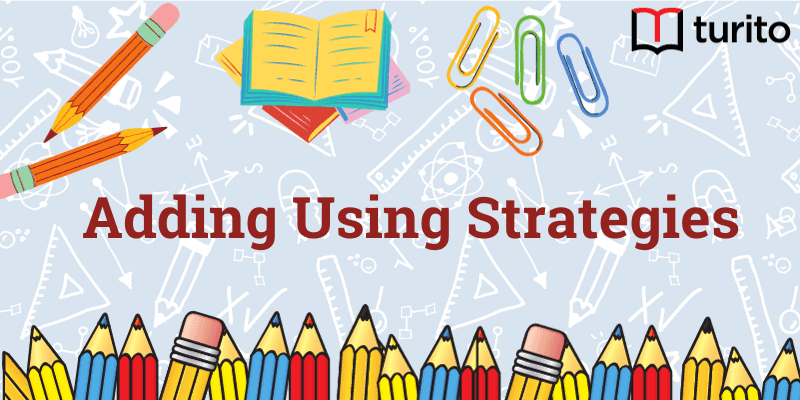Key Concepts
- Use partial sums to add 2-digit numbers.
- Break apart the numbers and then use mental math to find the sum.
Addition of two 2-digit numbers
We can add two 2-digit numbers by using different strategies:
- Partial sums
- Break apart the addends and use mental math
- Adding in any order
Partial sums
Example 1:
Find 15 + 27 + 13.
Answer:

By using partial sums
Look for compatible numbers to make tens.
7 + 3 = 10
10 + 5 = 15
Example 2:
Find 28 + 14 + 32 + 16.
Answer:

By using partial sums.
Look for compatible numbers to make tens.
8 + 2 = 10
4 + 6 = 10
10 + 10 = 20
Break apart the addends and use mental math
Example 3:
Find 48 + 22 + 15.
Answer:
Break apart the addends by place value.
Then use mental math.

Add the tens.
40 + 20 + 10 = 70
Add the ones.
8 + 2 + 5 = 15
Add the partial sums.
70 + 15 = 85
So, 48 + 22 + 15 = 85.
Example 4:
Find 50 + 23 + 17.
Answer:
Break apart the addends by place value.
Then use mental math.

Add the tens.
50 + 20 + 10 = 80
Add the ones.
0 + 3 + 7 = 10
Add the partial sums.
80 + 10 = 90
So, 50 + 23 + 17 = 90.
Add in any order
Example 5:
Find 17 + 21 + 19 + 33.
Answer:
By adding numbers in different order:

50 + 40 = 90
So, 17 + 21 + 19 + 33 = 90.
Model question
Question:
In the central part of the zoo, there were 29 four-legged animals, 15 two-legged animals and 8 animals with no legs. How many animals are there in the central part of the zoo?

Answer:
Number of four-legged animals = 29
Number of two-legged animals = 15
Number of animals with no legs = 8
To find the total number of animals in the zoo, we must find the sum of 29, 15, and 8.
29 + 15 + 8 = ?
By using partial sums:

29 + 15 + 8 = 52
So, there are 52 animals in the zoo.
Exercise
Question 1:
Find the sum of 43, 16, and 27.
Question 2:
Find the sum of 24, 16, 11 and 39.
Question 3:
Find 23 + 12 + 17 + 38.
Question 4:
Find 11 + 13 + 15 + 17 + 19.
Question 5:
The clown blew up thirty-seven balloons. The other two clowns blew up thirteen more balloons each. How many balloons do the clowns have now?
Question 6:
The zoo cashier counted all the tickets sold. They had sold 23 adult tickets and 28 tickets for kids. Together with 2 tickets sold for senior citizens, how many tickets were sold altogether?
Question 7:
Julia played tag with 14 kids on Monday. She played tag with 7 kids on Tuesday, 13 kids on Wednesday, and 16 kids on Thursday. How many kids did she play with altogether?
Question 8:
There are 42 cups of popcorn in the first popcorn machine and 36 cups of popcorn in the second popcorn machine. There are 20 empty popcorn cups. How many cups of popcorn are ready in total?
Question 9:
There were 18 strawberry plants in the first row and 34 plants in the second row and 16 plants in the third row. The farmer made a fourth row and planted 22 more strawberry plants. How many strawberry plants were there in the 3 rows?
Question 10:
One dress in the store comes in 3 different sizes. There are 21 size small, 24 size medium, and 29 size large. How many dresses are there altogether?
Concept Map

What we have learned
- Add and solve 2-digit numbers using different strategies.

Related topics
Addition and Multiplication Using Counters & Bar-Diagrams
Introduction: We can find the solution to the word problem by solving it. Here, in this topic, we can use 3 methods to find the solution. 1. Add using counters 2. Use factors to get the product 3. Write equations to find the unknown. Addition Equation: 8+8+8 =? Multiplication equation: 3×8=? Example 1: Andrew has […]
Read More >>Dilation: Definitions, Characteristics, and Similarities
Understanding Dilation A dilation is a transformation that produces an image that is of the same shape and different sizes. Dilation that creates a larger image is called enlargement. Describing Dilation Dilation of Scale Factor 2 The following figure undergoes a dilation with a scale factor of 2 giving an image A’ (2, 4), B’ […]
Read More >>How to Write and Interpret Numerical Expressions?
Write numerical expressions What is the Meaning of Numerical Expression? A numerical expression is a combination of numbers and integers using basic operations such as addition, subtraction, multiplication, or division. The word PEMDAS stands for: P → Parentheses E → Exponents M → Multiplication D → Division A → Addition S → Subtraction Some examples […]
Read More >>System of Linear Inequalities and Equations
Introduction: Systems of Linear Inequalities: A system of linear inequalities is a set of two or more linear inequalities in the same variables. The following example illustrates this, y < x + 2…………..Inequality 1 y ≥ 2x − 1…………Inequality 2 Solution of a System of Linear Inequalities: A solution of a system of linear inequalities […]
Read More >>Other topics











Comments: